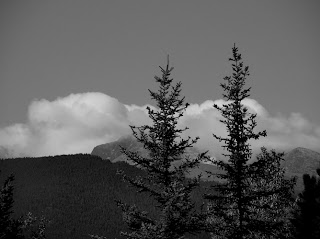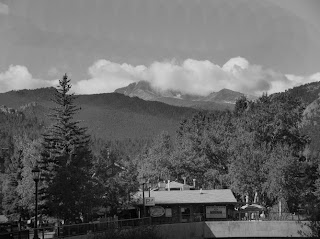Knowing how to work from a photo is essential for any painter and though plein air is my favorite way to work, the temps in Alamosa this last month have brought this particular lesson right to the fore.
Some simple rules (they're actually only guidelines)-
1.First and most important - We are NOT copying the photo; it is only reference. Knowing this will change how you look at your photos, how you take them and how you use them. For most beginning painters, using that gorgeous 'calendar' photo, leads to disappointment. You probably can't top it. I prefer to look for photos that have 'good bones'- not a great photo, per se, but one that has strong shapes and things that can be moved around. Which brings me to the next guideline...
2. Make a plan; the artist's job (even when working directly from life) is to select and arrange major shapes to lead the viewer's eye around the painting; this is composition.
Having a few simple compositional ideas in mind beforehand and you will be able to selectively view what is presented and fit it to a design scheme that works. (See past Class Notes: 'Composition' and 'The Big Idea'). It will also keep you from placing elements arbitrarily. Sometimes this involves changing or moving things for the sake of a design idea.
Is that mountain going the wrong direction or are there too many trees? - move or change them. Get rid of what isn't working and only use what does. One good thing about using a photo is that you can use it again and again, make many studies and take some risks.
1.26.2008
Class Notes, Working from Photos


The Thursday evening Painting Class used these 2 black and white pieces of photo reference to paint from and each painter came up with a very nice and a very distinctive painting. Not unlike 5 painters in the landscape where you end of with 5 very different views and points of view; photo reference material allows each person the freedom of expression and variation in composition - that is as long as the goal is NOT to copy the photo.
Class Notes, Working from Photos
1.24.2008
Class Notes, Color Temperature
Temperature is one of the 4 characteristics of color; the others being: Hue (or local color), Intensity (its brightness), and Value (the dark or light of a color).
As we look at the color wheel the yellow, orange, red colors are the warm range and the green, blue, violet colors are considered the cool range. Within each color, however, is a warm and cool version.
For example - RED is considered a warm color but the tube color Alizarin Crimson is a cool version of red, especially when compared with Cadmium Red Light, which is a warm (and quite orange) red. Both are in the RED family, but Alizarin is the cooler and more violet red, while Cad Red Light gives us a warmer version in the same family.
When painting with Alizarin in the landscape or in a still life, try highlighting it with Cad Red Light, thus adding depth to the work and more interest by not only changing color value but changing color temperature.
As we look at the color wheel the yellow, orange, red colors are the warm range and the green, blue, violet colors are considered the cool range. Within each color, however, is a warm and cool version.
For example - RED is considered a warm color but the tube color Alizarin Crimson is a cool version of red, especially when compared with Cadmium Red Light, which is a warm (and quite orange) red. Both are in the RED family, but Alizarin is the cooler and more violet red, while Cad Red Light gives us a warmer version in the same family.
When painting with Alizarin in the landscape or in a still life, try highlighting it with Cad Red Light, thus adding depth to the work and more interest by not only changing color value but changing color temperature.
Subscribe to:
Comments (Atom)
